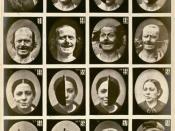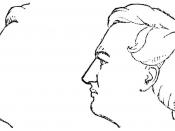II. Rewiew of LiteratureAccording to "Culture and Facial Expressions of Emotion", by David Matsumoto, people from different cultures express emotions differently. An example of this is demonstrated with a study by Friesen's study in 1972. Friesen studied the spontaneous expressions of Americans and Japanese. This study revieled, that when alone, both cultures expressed similar feelings of disgust, sadness, fear, and anger. However, when presented with the company of an older male in the room, things changed. By adding another person to the room Americans continued to express their negative emotions while the Japanese were more likely to mask their negative emotions with a smile (Nonverbal Communication Reader, p. 413).
"Other researchers have also examined cultural differences in emotional expression (Nonverbal Communication Reader, p. 413)." In addition to study's done by Ekman, in 1972, and by Friesen, in 1972, Matsumoto is able to extend their origional theories with his own laboratory findings.
European American females were classified as either individualistic or collectivist based on their responses to an individual difference measure and were then videotaped while watching films that were designed to create positive and negative emotions. Similarly to Friesen's study, the experiment contained the variable of being alone verse accompanied by an experimenter. Then, they were asked to rate their emotional responses to both films in both conditions, and samples of their emotional expressions were judged by a separate group of decoders. The only difference noted in this experiment was during the attendence of the experimenter during the viewing. The collectivists masked their negative expressions often with a smile. Matsumoto's finding was congruent with the findings of Ekman and Friesen. This study then comfortly concluded that, "â¦the effects of culture on expression were not limited to negative emotions (Nonverbal Communication Reader, p. 413-414)."III.


